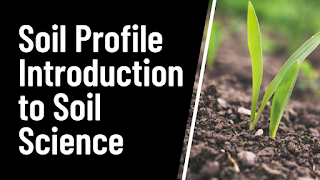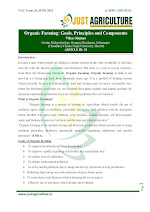Soil Profile
Definition:- The vertical section of the soil showing the various layers from the surface to the unaffected parent material is known as a soil profile. The various layers are known as horizons. A soil profile contains three main horizons.
They are named as horizon A, horizon B and horizon C.
- The surface soil or that layer of soil at the top which is liable to leaching and from which some soil constituents have been removed is known as horizon A or the horizon of eluviation.
- The intermediate layer in which the materials leached from horizon A have been redeposited is known as horizon B or the horizon of illuviation.
- The parent material from which the soil is formed is known as horizon C.
- A Study of soil profile is important as it is historic record of all the soil forming processes and it forms the basis for the study in pedagogical investigations.
- Soil profile is the key for the soil classification and also forms the basis for the practical utility of soils.
- A hypothetical mineral soil profile will include O, A, B, C and R master horizons and all the possible sub-horizons.
Master Horizons and Sub Horizons
(1). O
Horizon:- It is called as organic horizon. It is found in
the upper part of the mineral soil, dominated by fresh or partly decomposed
organic materials. This horizon contains
more than 30% organic matter if mineral fraction has more than 50 % clay (or)
more than 20 % organic matter if mineral fraction has less clay. The organic horizons are commonly seen in
forest areas and generally absent in grassland, cultivated soils. This horizon is classified in further classes:-
- O1 Horizon - Organic horizon in which is developed by the original residues of plant and animal which also can be recognized through naked eye.
- O2 Horizon - Organic horizon in which is developed by the original residues of plant and animal and can not be recognized through naked eye.
(2). A - horizon:- Horizon of organic matter accumulation adjacent to surface and that
has lost. This horizon is classified in further classes:-
- A1 - Top most mineral horizon formed adjacent to the surface. There will be clay, iron and aluminium, accumulation of humified organic matter associated with mineral fraction and darker in Colour than that of lower horizons due to organic matter.
- A2 - Horizon of maximum eluviation of clay, iron and aluminium oxides and organic matter. Loss of these constituents generally results in accumulation of quartz and other sand and silt size resistant minerals. Generally lighter in Colour than horizons above and below.
- A3 - A transitional layer between A and B horizons with more dominated properties of A1 or A2 above than the underlying B horizon. This horizon is sometimes absent.
(3). B - Horizon:- Horizon in which the dominant features are accumulation of clay,
iron, aluminium or humus alone or in combination. Coating of sesquioxides will
impart darker, stronger of red Colour than overlying or underlying horizons.
- B1 horizon - A transitional layer between A and B. More like A than B.
- B2 horizon - Zone of maximum accumulation of clay, iron and aluminium oxide that may have moved down from upper horizons or may have formed in situ. The organic matter content is generally higher and Colour darker than that of A2 horizon above.
- B3 horizon - Transitional horizon between B and C and with properties more similar to that of overlying B2 than underlying C.
(4). C horizon:- It is the horizon below the solum (A + B), relatively less affected by soil forming processes. It is outside the zone of major biological activity. It may contain accumulation of carbonates or sulphates, calcium and magnesium .
Note:- A, B and C horizons are collectively called Regolith (A+B+C).
(5). R horizon:- Underlying consolidated bed rock and it may or may not be like the parent
rock from which the solum is formed.
Special Features
Soil
Individual or Polypedon:- The Soil Survey Staff (1960)
defined the soil individual or polypedon (Pedon, Ground) as a natural unit of
soil that differs from its adjoining unit on the landscape in one or more
properties.
- Pedon:- The term pedon has been proposed for small basic soil entities that are part of the continuum mantling the land.
- A pedon is the smallest volume that can be called "a soil". The set of pedons must fit within the range of one series and occur in a contiguous group to form a polypedon.
- Polypedon:- A polypedon is therefore, defined as a contiguous similar pedons bounded on all sides by "not soil or by pedons of unlike characters. It is a real physical soils body which has a minimum area of more than 1 sq. km and an unspecified maximum area.











0 Comments